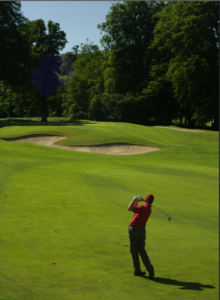Wedge Play
“Do not try to keep your head down in wedge play”
Although I have seen and heard this advice given a number of times by good coaches it still seems to be something that some club/social golfers revert to as a swing thought in playing wedge shots. This largely leads to immobilising the torso rotation through impact, we now loose body/arm connection and natural weight movement which in turn creates the tendency to become too flippy or “hands” at impact. All of which means you will struggle to control the force or pressure you impart on the ball and the trajectory of the shot – two main points to good wedge play. The key message here is to let yourself move naturally through the shot whilst still maintaining your initial posture angle but don’t stop moving at impact.
One of the more common questions that get asked about playing wedges is how to get spin. The real simple answer here is you need to have the right conditions to create a lot of friction between the ball and face at impact. To do this it’s worth noting the following points.
- The type of lie plays a big role in setting the limits of creating spin.
- More friction will tend to lower the ball flight regardless of the loft on the club. In other words a ball coming off a 48 degree club that has a lot of spin will fly lower that a ball that has been hit with the same loft but has a lot less spin.
- A wet ball, wet clubface will typically reduce friction therefore leads to a higher ball flight.
- The primary role for grooves is to disperse any moisture or substance that gets between the ball and face. You should always try to hit wedge shots with a clean face especially the grooves. Also older clubs with worn grooves will have less chance of spinning a ball than those with newer grooves.
- A premium golf ball when struck correctly will always flight the ball lower and spin more than non-premium golf balls.
- I have found that you will get more friction with a bottom of the ball contact as opposed to a back of the ball contact. This means the bounce or sole of the clubs interaction with the ground is more a brushing rather than a digging effect that has big deep divots.
Overall if a player adds skill development and variability to their practice and not just blocked or repetitive training when working on your wedge game it gives you the best opportunity to explore and improve your scoring potential in your golf.

